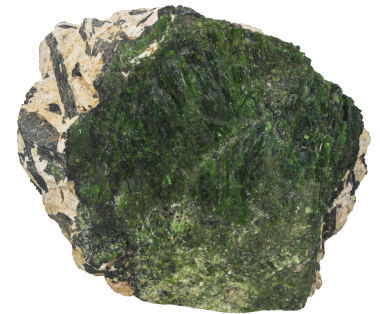En
10:00 - 19:00
Monday - Thursday
open 10 am - 7 pm
open 10 am - 7 pm
✱
Friday - Sunday
laboratory is closed
laboratory is closed
Chrome-diopside
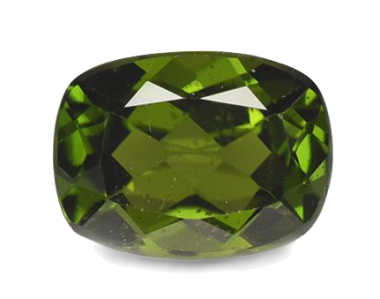
Chrome-diopside is a chromiferous variety of the diopside mineral. The name of the variety comes from the name of the mineral species - “diopside” and the chromophore impurity of the chemical element, the ions of which cause the characteristic green color - “chrome”.
Chrome-diopside is colored with a basic green color with an admixture of shades of yellow or blue, depending on additional chromophore impurities. Coloring, as a rule, has a high degree of saturation. The chromophore content of chromium on average is about 0.5%, but in some cases it can reach up to 2% (in terms of Cr2O3).
In the 1990s, chrome-diopside was advertised under the trade name "Yakut emerald", but since this term can be misleading with respect to the mineral species, this brand was found to be incorrect and not recommended for use. However, you can still hear this beautiful and romantic name - "Yakut emerald", which has no relation to either emerald or beryl.
Chrome-diopside is colored with a basic green color with an admixture of shades of yellow or blue, depending on additional chromophore impurities. Coloring, as a rule, has a high degree of saturation. The chromophore content of chromium on average is about 0.5%, but in some cases it can reach up to 2% (in terms of Cr2O3).
In the 1990s, chrome-diopside was advertised under the trade name "Yakut emerald", but since this term can be misleading with respect to the mineral species, this brand was found to be incorrect and not recommended for use. However, you can still hear this beautiful and romantic name - "Yakut emerald", which has no relation to either emerald or beryl.
Chemistry: Ca(Mg,Cr)[Si2O6];
Crystal system: Monoclinic, Monoclinic-prismatic symmetry class (point symmetry group);
Color: The main green color of chrome-diopside is caused by the presence of an impurity of Сr63+ ions, isomorphically replacing magnesium in the structure of diopside, and the yellow and brown shades are associated with an isomorphic admixture of iron ions Fe3+. In some species, isomorphic V3+ impurity also influences coloring.
Identification properties
| Physical properties | |
|---|---|
| Mohs hardness: | 5.5 – 6.5 |
| Density: | 3,22 – 3,40 g/cm3 |
| Cleavage: | on {110} average |
| Fracture: | rough, staggered |
| Optical properties | |
|---|---|
| Optical character: | anisotropic, biaxial (positive) |
| Refractive Index: | np =1,663 – 1,669, nm =1,671 – 1,705, ng =1,693 – 1,728 |
| Birefringence: | 0.025 – 0.031 |
| Pleochroism: | weak (yellowish green - green) |
| Dispertion: | 0,017 – 0,020 (BG) |
| Luster: | glassy |
Inclusions and structural inhomogeneities
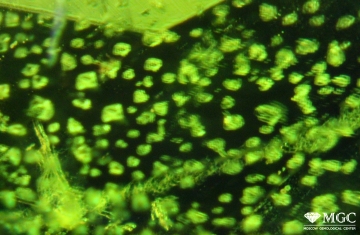
Inclusions of type reverse crystal in natural chrome-diopside. View mode - dark field lighting
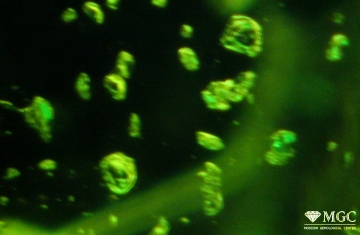
Two-phase inclusions in natural chrome diopside. View mode - dark field lighting
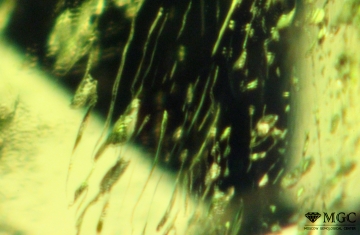
Three-phase inclusions in natural chrome-diopside. View mode - dark field lighting
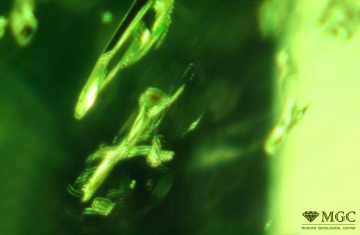
Inclusions of phlogopite in natural chrome-diopside. View mode - dark field lighting
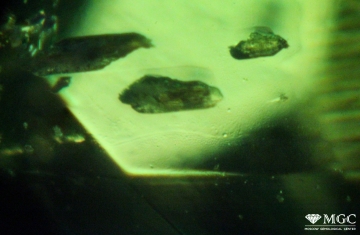
Inclusions of phlogopite in natural chrome-diopside. View mode - dark field lighting
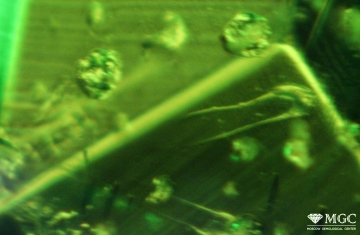
Mineral inclusions of apatite in natural chrome-diopside. View mode - dark-field lighting
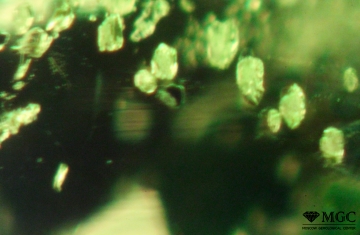
Mineral inclusions of apatite and potassium feldspar in natural chrome diopside. View mode - dark field lighting
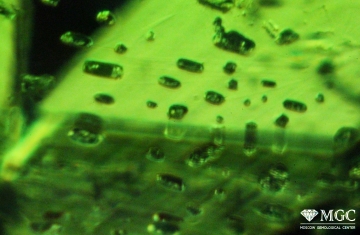
Multiphase inclusions type reverse crystal. View mode - dark field lighting

Ring crack around mineral inclusion. View mode - dark field lighting
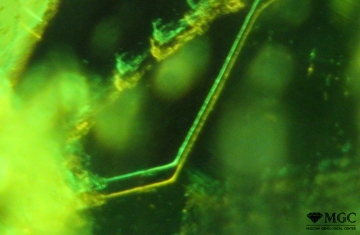
Birefringence in natural chrome-diopside. View mode - dark field lighting
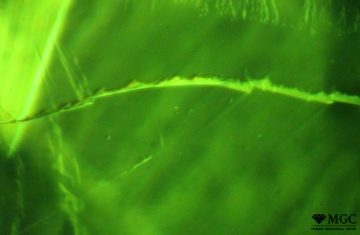
Crack with spike punctures in natural chrome-diopside. View mode - dark field lighting
Gem basic treatments
| Treatment | Goal |
|---|---|
| Impregnated with adhesive | Strengthen, prevent splintering, improve cleanliness |
| Impregnation with various coloring compounds | Altering the gem visual color |
| Surface coating by applying a various coloring agent | Altering the gem visual color |
Synthetic or Imitation gem materials
Synthetic chrome-diopside is not produced for the jewelry industry.
As imitations of chrome-diopside are used as follows:
-
synthetic minerals with similar color (cubic zirconia, garnets, spinel, corundum);
- doublets and triplets: glass + natural or synthetic chrome diopside / diopside;
- color glass;
mgc-labs.ru © 2014–2024
All rights reserved


